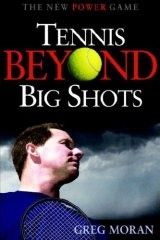January 2007 Article
Mortal Tennis/Circle Game Archive
Tennis Server
|

 |
Think back to your very first tennis lesson. After the instructor showed you which end of the racket to hold, how to stand and demonstrated your first stroke, what did he say next? I’ll bet you my autographed picture of Rod Laver that the next words out of his mouth were "now be sure to watch the ball." "Watch the ball." It’s the first tip most of us ever received and will always be the game’s most important piece of advice. However, listening to the ball might be a close second. By paying attention to the sound as the ball strike’s your opponent’s racket, you can pick up how hard or soft it’s been hit, if it’s been hit with excessive spin or if it’s been mis-hit. Each has its own distinctive sound. A hard hit ball sounds like a big "boom" while a ball hit softly sounds more like a "tap." A ball that’s been hit with excessive spin makes a "hissing" sound" and a mis-hit shot bears that unmistakable, ear-cringing, noise that I often compare to fingernails running down a blackboard. By watching and listening to the ball you’ll pick up cues as to where your opponent’s shot is going to bounce and what it’s going to do after it lands. You can then respond accordingly. For example, if you see that the ball is three feet or higher above the net and sounds as if it’s been hit hard (boom) you need to immediately begin backing up. Conversely, if the ball comes off your opponent’s racket less than three feet over the net and the sound is softer (tap), you need to quickly start moving forward. If you hear the sound of spin (hiss) and see that your opponent has swung with a low to high motion, they’ve hit with topspin which means the ball will jump at you and bounce up after it lands. If you hear the "hiss" and the swing was a high to low motion that means slice which will cause the ball to stay low or even die as it hits the court. If you’re opponent has mis-hit their shot (fingernails on the blackboard) it’s very difficult to determine which way the ball will dance after it bounces. If at all possible, try to move forward and take it in the air so you won’t have to deal with the unpredictable spin that the mis-hit has placed on the ball. If you can’t reach the ball in time and must let it bounce, get to the spot where you anticipate it will land as quickly as possible and be prepared for it to jump one way or the other. Most of the time, you’ll be able to react quickly enough to get the ball back in play. A few years back there was a big controversy surrounding airplanes that flew over the stadium during the U.S. Open in New York. Fans thought that the players were complaining that the noise from the planes was disturbing the concentration when, in fact, they were equally upset because they couldn’t hear the ball as it hit their opponents racket. In response, then mayor, David Dinkins, a huge tennis fan actually rerouted the planes so that they would stay away from the U.S. Open site. In fact, Joel Drucker writes on www.thetennischannel.com that "the USTA orchestrated a 99-year lease that fines New York for unnecessary flyovers by jets taking off from nearby LaGuardia Airport. Under the lease, the city is liable for up to $325,000 if planes disrupt the tournament." More recently, a controversy has arisen on the pro tour surrounding grunting and its effect on the player’s ability to hear the ball being struck. Serena Williams and Maria Sharapova are two players whose habit of grunting loudly as they hit their shots has drawn complaints from their opponents. They claim that the noise disrupts their concentration as well as their ability to hear the ball being hit. The next time you play, put on a pair of earmuffs or stuff some cotton in your ears. You’ll be amazed at how important hearing the ball is for your preparation. By watching and listening as your opponent strikes the ball you’ll get a much quicker sense of where their shot is going and what it’s going to do after it lands. This will then allow you to begin your preparation that much sooner. And, as we all know, early preparation is the key to sound stroke production.
This column is copyrighted by Greg Moran, all rights reserved.
Greg Moran is the Head Professional at the Four Seasons Racquet Club in Wilton, Connecticut. He is a former ranked junior and college player and certified by both the USPTA and USPTR. Greg has written on a wide variety of tennis-related subjects for numerous newspapers and tennis publications including Tennis, Tennis Match and Court Time magazines. He is also a member of the FILA and WILSON Advisory Staffs.
Questions and comments about these columns can be directed to Greg by using this form.
|



October 2022 Tennis Anyone: Patterns in Doubles by John Mills. September 2022 Tennis Anyone: Short Court by John Mills. |

 You will join 13,000 other subscribers in receiving news of updates to the Tennis Server along with monthly tennis tips from tennis pro Tom Veneziano.
You will join 13,000 other subscribers in receiving news of updates to the Tennis Server along with monthly tennis tips from tennis pro Tom Veneziano. 